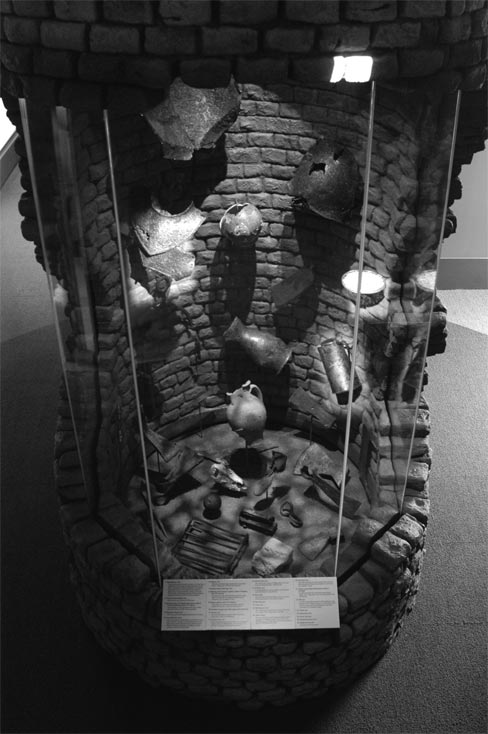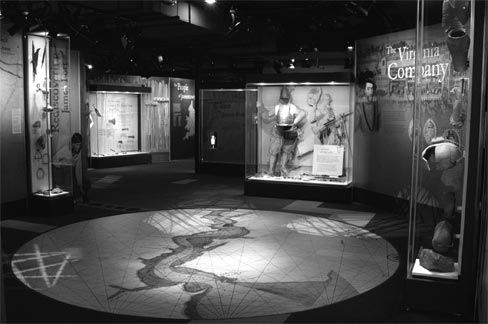Exhibit Review
The Archaearium at Historic Jamestowne
Historic Jamestowne, Jamestown, VA; APVA Preservation Virginia and the National Park Service
Permanent
The Archaearium at Historic Jamestowne in Virginia highlights the important contributions of historical archeology to our understanding of the first permanent English settlement in North America.(1) Using artifacts collected over the past 14 years at the site of James Fort, the original fort built by English settlers in 1607, the Archaearium tells the exciting story of the first English colonists, their economic aspirations, their interactions with Powhatan Indians, and the trials and tribulations they faced as they struggled to survive in the New World.
The exhibits challenge earlier document-based interpretations of the Jamestown colonists as ill prepared for their adventure. The archeological evidence suggests that the first colonists were, in fact, organized and well provisioned. Investigative in nature, the Archaearium's displays raise provocative questions about the lives of the first English colonists and leave just enough mystery about what life was like in early Jamestown to fire the imagination of visitors.
The Archaearium is part of a larger interpretive program at Historic Jamestowne jointly designed and administered by APVA Preservation Virginia (formerly the Association for the Preservation of Virginia Antiquities) and the National Park Service. The facility is a recent addition to Historic Jamestowne, and it has opened in time for this year's celebration and commemoration of the 400th anniversary of the site of the first permanent English settlement in the Americas. Modern and interactive, the museum displays the artifacts collected by the APVA's Jamestown Rediscovery archeological program directed by William Kelso.
The Archaearium is a beautifully designed one-story, copper-clad structure built over the site of Jamestown's last statehouse (1660-1698). Glass floor panels allow visitors to walk over and view the original foundations of that structure. Markers commemorate the more than 70 individuals from the mid 1600s whose skeletal remains were recovered during excavations of the statehouse site (the remains will be reinterred in a commemorative courtyard at the Archaearium). The Archaearium building itself blends with the natural landscape, and it is an environmentally friendly facility that embraces the latest in green technology.
The Archaearium addresses a number of settlement themes. One installation highlights artisans at Jamestown and displays the artifacts of their trades, including tools used for blacksmithing, glassmaking, tailoring, leatherworking, and coopering. Crucibles recovered from the site, for example, indicate the practice of metallurgy and underscore the advanced nature of the scientific instruments used by the first colonists. Also on display are carpentry and woodworking tools recovered during the excavations that were of the type used to construct James Fort and its buildings. A cut-away model of the barracks within James Fort shows the unique mud-and-stud construction techniques used by the first colonists. This architectural style is unknown at other British colonial sites in the Americas.
The section called "The Golden Leafe" showcases the colonists' early forays into tobacco production and presents an array of clay tobacco pipes that attest to the extent of tobacco smoking among the first colonists. Among the pipes on display are those made of local Virginia clay. Some bear the maker's mark of Robert Cotton, one of the first English colonists at Jamestown.
 |
This cutaway section of the reconstructed well shows the variety and location of the numerous objects found during the excavation of the well at James Fort. (Courtesy of APVA Preservation Virginia.) |
In the section, "Small Finds," visitors get a chance to see some of the little objects of daily life that reflect the tastes and activities of the first settlers. Among the small finds are gaming pieces, jewelry, and musical instruments. Religious artifacts suggest that Catholics were among the first colonists at Jamestown, a site historically associated with the Church of England. The many early 17th-century coins on display represent pieces from around Europe and underscore the extent of economic relations spanning the Atlantic, and conch shells, limestone block, and other objects recovered at the site relate the fateful voyage of Sea Venture, which ran aground in Bermuda before making its way to Jamestown. The saga of Sea Venture's voyage and the adventures of its stranded crew provided the inspiration for William Shakespeare's The Tempest.
Whereas some of the installations emphasize the English experience at Jamestown, others focus on the interactions (both the peaceful and violent) between the English colonists and the Powhatan Indians. The section titled "Contact" displays imported glass beads and copper tinkling cones used as mediums of exchange with the Powhatan. Visitors will also see archeological evidence of Powhatan contributions to English foodways and implements used for hunting and fishing.
Foodways figure prominently throughout the Archaearium, from the display of faunal remains to panels on the "Starving Time," a period of food shortage during which many colonists died. The bones of dogs, horses, turtles, and bald eagles in Jamestown's trash deposits attest to the scarcity of food during that period. The Archaearium also highlights the difficulties in finding safe and clean drinking water. A reconstructed fort well helps tell the story of Jamestown's unhealthy water supplies. Excavations at the well site provided archeologists with a great deal of information about the first colonists. A section of the reconstructed well is cut away to show the extensive array of ceramic, iron, and leather materials recovered from this time capsule.
The focal point of the Archaearium is a room set aside for the human skeletal remains recovered from James Fort. The exhibit area includes the presumed remains of Captain Bartholomew Gosnald, one of the key leaders of the Jamestown settlement. The display tells how archeologists used grave goods and advanced forensic techniques to help link the remains to Gosnald. Also on display is a resin cast of the skeletal remains of a man known simply as JR, who was killed by a musket ball shot to his leg (the Jamestown Rediscovery archeological team found the musket ball with the skeleton). "Who Shot JR?" is one of the key mysteries of the James Fort site, and this sensational find has helped shed new light on the early hardships and conflicts at James Fort.
One of the most interesting technological features of the Archaearium is an interactive viewer that enables visitors to look out on the landscape and superimpose James Fort and its buildings on the monitor. An audio device attached to the viewer helps visitors pinpoint certain features of the fort and learn more about the archeological investigations.
The Archaearium will take one to two hours to appreciate fully. The entrance fee to Historic Jamestowne is a nominal amount, considering the experience. The visitor center offers additional information about the settlement and a 15-minute film that showcases Jamestown as a place where European, Native American, and African cultural traditions came together in North America. After the film, visitors can walk through the reconstructed frame of the 1607 James Fort, and on weekdays, observe actual archeological excavations at the site. Visitors can walk through the reconstructed foundations of New Towne, just to the east of James Fort, which became a center of trade activity for Chesapeake colonists in the mid-17th century. Guides and volunteers are located throughout Historic Jamestowne to direct visitors and help answer questions.
Jamestown Island is a beautiful place for a leisurely walk. Spring and fall are the best times to visit. The August heat can be stifling, and the winds in January can be harsh. The Archaearium will offer a nice reprieve from the elements during any season.
Frederick H. Smith
College of William and Mary
Note
1. Information about the Historic Jamestowne Archaearium is available online at http://www.historicjamestowne.org/visit/archaearium.php, accessed May 11, 2007.

